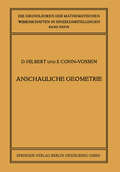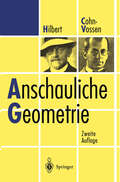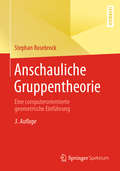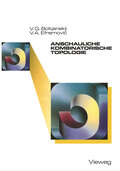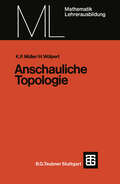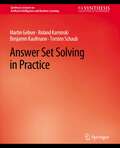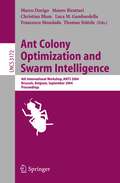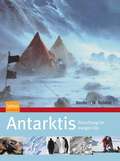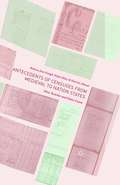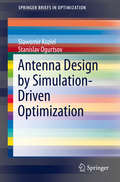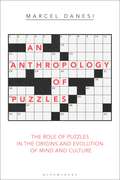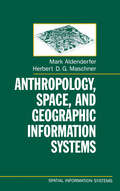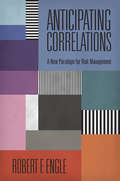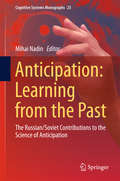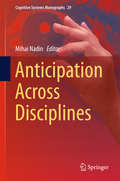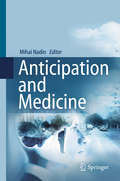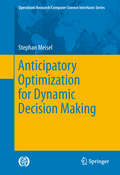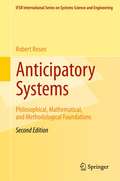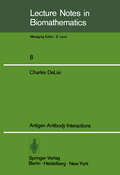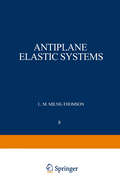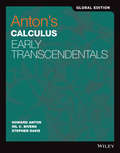- Table View
- List View
Anschauen, Anfassen, Auffassen.: Eine Wissensgeschichte Mathematischer Modelle (Mathematik im Kontext)
by Anja SattelmacherDas Herstellen, Sammeln und Verbreiten mathematischer Modelle war im 19. und frühen 20. Jahrhundert weit verbreitete Praxis an Universitäten und technischen Hochschulen.Anhand ausgewählter Modelle im Kontext ihrer Sammlungen lässt sich zeigen, dass das Wissen über mathematische Modelle im Prozess der Modellierung, des Sammelns, des Veräußerns und des Ausstellens generiert wurde. Dabei flossen sowohl künstlerische Praktiken als auch reformpädagogische Überlegungen in dieses Wissen mit ein. Im Zentrum der Studie stehen Mathematikprofessoren, die die Verwendung von Modellen im Kontext der akademischen Lehre auf unterschiedliche Weise vorantrieben. Weniger bekannt ist hingegen, dass auch Frauen einen wichtigen Anteil an der Produktion von Modellen hatten. Das Buch leistet mit den Auswertungen zahlreicher Quellen aus unterschiedlichen Archiven sowie einer ethnographischen Beobachtung eines Modellbauers einen wichtigen Beitrag für eine praxeologisch orientierte Wissenschaftsgeschichte.
Anschauliche Geometrie (Grundlehren der mathematischen Wissenschaften #37)
by David Hilbert Stefan Cohn-VossenDieser Buchtitel ist Teil des Digitalisierungsprojekts Springer Book Archives mit Publikationen, die seit den Anfängen des Verlags von 1842 erschienen sind. Der Verlag stellt mit diesem Archiv Quellen für die historische wie auch die disziplingeschichtliche Forschung zur Verfügung, die jeweils im historischen Kontext betrachtet werden müssen. Dieser Titel erschien in der Zeit vor 1945 und wird daher in seiner zeittypischen politisch-ideologischen Ausrichtung vom Verlag nicht beworben.
Anschauliche Geometrie
by David Hilbert Stephan Cohn-Vossen1932 erstmals erschienen, hat der Klassiker der Geometrie bis heute nichts von seiner Frische und Kraft eingebüßt. Die weltbekannten Autoren stellen in dem Band zugrundeliegende Leitmotive und verblüffende Zusammenhänge in der Geometrie verständlich dar. David Hilbert, dessen Ziel es war, die Faszination der Geometrie zu vermitteln, schrieb im Vorwort: „Das Buch soll dazu dienen, die Freude an der Mathematik zu mehren, indem es dem Leser erleichtert, in das Wesen der Mathematik einzudringen, ohne sich einem beschwerlichen Studium zu unterziehen".
Anschauliche Gruppentheorie: Eine computerorientierte geometrische Einführung
by Stephan RosebrockMan kann Gruppen als algebraische Objekte auffassen, die die Symmetrie von geometrischen Objekten beschreiben. Dieser Blickwinkel steht bei dem Buch im Vordergrund und somit geht es in dem Buch auch um Geometrie. Gruppen drücken Symmetriephänomene algebraisch aus, man rechnet mit Spiegelungen, Drehungen usw., allgemein mit Abbildungen von Räumen auf sich. Das Buch kann vorlesungsbegleitend bei Algebra- und Gruppentheorie-Vorlesungen eingesetzt werden. Es eignet sich auch besonders gut für Lehramtsstudierende, da es den Stoff computerorientiert (unter Benutzung des frei erhältlichen Gruppentheorie-Programms GAP) mit vielen anschaulichen Beispielen präsentiert. Für die 2. Auflage wurden einige Teile des Buches ausführlicher dargestellt. Einige Inhalte (zum Beispiel die Klassifikation der endlichen Gruppen bis zur Ordnung 11) wurden hinzugefügt und Fehler korrigiert.
Anschauliche Höhere Mathematik für Ingenieure und Naturwissenschaftler 1: Lineare Algebra, eindimensionale Analysis: Ein graphisch orientierter Zugang
by Markus NeherDas Buch bietet eine anschauliche und sorgfältige Einführung in die Höhere Mathematik mit didaktisch gut durchdachtem Aufbau, bei dem nahezu alle Sachverhalte aus den zuvor behandelten Inhalten hergeleitet und begründet werden. Die hierarchische Gliederung unterstützt das vernetzte Lernen, das für eine sichere und langfristige Beherrschung des Stoffs unerlässlich ist. Band 1 behandelt Lineare Algebra sowie Differenzial- und Integralrechnung einer Veränderlichen, einschließlich einiger numerischer Themen.Die vielen professionell gestalteten Graphiken tragen zum Verständnis ebenso bei wie die vollständig gerechneten Beispiele. Ein wertvoller Begleiter für alle Studierenden in ingenieur- und naturwissenschaftlichen Studiengängen. Studierenden in Mathematikstudiengängen, insbesondere im Lehramt, kann das Buch als anschauliche Einführung in die Differenzial- und Integralrechnung einer und mehrerer Veränderlicher dienen.
Anschauliche Höhere Mathematik für Ingenieure und Naturwissenschaftler 2: Mehrdimensionale Analysis, Differenzialgleichungen: Ein graphisch orientierter Zugang
by Markus NeherDas Buch bietet eine anschauliche und sorgfältige Einführung in die Höhere Mathematik mit didaktisch gut durchdachtem Aufbau, bei dem nahezu alle Sachverhalte aus den zuvor behandelten Inhalten hergeleitet und begründet werden. Die hierarchische Gliederung unterstützt das vernetzte Lernen, das für eine sichere und langfristige Beherrschung des Stoffs unerlässlich ist. Band 2 behandelt Differenzial- und Integralrechnung mehrerer Veränderlicher, Vektoranalysis und gewöhnliche Differenzialgleichungen, einschließlich numerischer Verfahren und eines Ausblicks auf partielle Differenzialgleichungen.Die vielen professionell gestalteten Graphiken tragen zum Verständnis ebenso bei wie die vollständig gerechneten Beispiele. Ein wertvoller Begleiter für alle Studierenden in ingenieur- und naturwissenschaftlichen Studiengängen. Studierenden in Mathematikstudiengängen, insbesondere im Lehramt, kann das Buch als anschauliche Einführung in die Differenzial- und Integralrechnung einer und mehrerer Veränderlicher dienen.
Anschauliche Topologie: Eine Einführung die elementare Topologie und Graphentheorie (Mathematik für die Lehrerausbildung)
by Kurt Peter Müller Heinrich WölpertAnswer Set Solving in Practice (Synthesis Lectures on Artificial Intelligence and Machine Learning)
by Martin Liu Roland RoijersAnswer Set Programming (ASP) is a declarative problem solving approach, initially tailored to modeling problems in the area of Knowledge Representation and Reasoning (KRR). More recently, its attractive combination of a rich yet simple modeling language with high-performance solving capacities has sparked interest in many other areas even beyond KRR. This book presents a practical introduction to ASP, aiming at using ASP languages and systems for solving application problems. Starting from the essential formal foundations, it introduces ASP's solving technology, modeling language and methodology, while illustrating the overall solving process by practical examples. Table of Contents: List of Figures / List of Tables / Motivation / Introduction / Basic modeling / Grounding / Characterizations / Solving / Systems / Advanced modeling / Conclusions
Ant Colony Optimization and Swarm Intelligence: 4th International Workshop, ANTS 2004, Brussels, Belgium, September 5-8, 2004, Proceeding (Lecture Notes in Computer Science #3172)
by Marco Dorigo Thomas Stützle Mauro Birattari Christian Blum Luca M. Gambardella Francesco MondadaAntecedents of Censuses from Medieval to Nation States: How Societies and States Count
by Dylan Riley Rebecca Jean Emigh Patricia AhmedAntecedents of Censuses From Medieval to Nation States, the first of two volumes, examines the influence of social formations on censuses from the medieval period through current times. The authors argue that relative influence of states and societies is probably not linear, but depends on the actual historical configuration of the states and societies, as well as the type of population information being collected. They show how information gathering is an outcome of the interaction between states and social forces, and how social resistance to censuses has frequently circumvented their planning, prevented their implementation, and influenced their accuracy.
Antenna Design by Simulation-Driven Optimization (SpringerBriefs in Optimization)
by Slawomir Koziel Stanislav OgurtsovThis Brief reviews a number of techniques exploiting the surrogate-based optimization concept and variable-fidelity EM simulations for efficient optimization of antenna structures. The introduction of each method is illustrated with examples of antenna design. The authors demonstrate the ways in which practitioners can obtain an optimized antenna design at the computational cost corresponding to a few high-fidelity EM simulations of the antenna structure. There is also a discussion of the selection of antenna model fidelity and its influence on performance of the surrogate-based design process. This volume is suitable for electrical engineers in academia as well as industry, antenna designers and engineers dealing with computationally-expensive design problems.
An Anthropology of Puzzles: The Role of Puzzles in the Origins and Evolution of Mind and Culture
by Professor Marcel DanesiAn Anthropology of Puzzles argues that the human brain is a "puzzling organ" which allows humans to literally solve their own problems of existence through puzzle format. Noting the presence of puzzles everywhere in everyday life, Marcel Danesi looks at puzzles in society since the dawn of history, showing how their presence has guided large sections of human history, from discoveries in mathematics to disquisitions in philosophy. Danesi examines the cognitive processes that are involved in puzzle making and solving, and connects them to the actual physical manifestations of classic puzzles. Building on a concept of puzzles as based on Jungian archetypes, such as the river crossing image, the path metaphor, and the journey, Danesi suggests this could be one way to understand the public fascination with puzzles. As well as drawing on underlying mental archetypes, the act of solving puzzles also provides an outlet to move beyond biological evolution, and Danesi shows that puzzles could be the product of the same basic neural mechanism that produces language and culture. Finally, Danesi explores how understanding puzzles can be a new way of understanding our human culture.
Anti-Differentiation and the Calculation of Feynman Amplitudes (Texts & Monographs in Symbolic Computation)
by Johannes Blümlein Carsten SchneiderThis volume comprises review papers presented at the Conference on Antidifferentiation and the Calculation of Feynman Amplitudes, held in Zeuthen, Germany, in October 2020, and a few additional invited reviews. The book aims at comprehensive surveys and new innovative results of the analytic integration methods of Feynman integrals in quantum field theory. These methods are closely related to the field of special functions and their function spaces, the theory of differential equations and summation theory. Almost all of these algorithms have a strong basis in computer algebra. The solution of the corresponding problems are connected to the analytic management of large data in the range of Giga- to Terabytes. The methods are widely applicable to quite a series of other branches of mathematics and theoretical physics.
Anticipating Correlations: A New Paradigm for Risk Management (PDF)
by Robert EngleFinancial markets respond to information virtually instantaneously. Each new piece of information influences the prices of assets and their correlations with each other, and as the system rapidly changes, so too do correlation forecasts. This fast-evolving environment presents econometricians with the challenge of forecasting dynamic correlations, which are essential inputs to risk measurement, portfolio allocation, derivative pricing, and many other critical financial activities. In Anticipating Correlations, Nobel Prize-winning economist Robert Engle introduces an important new method for estimating correlations for large systems of assets: Dynamic Conditional Correlation (DCC). Engle demonstrates the role of correlations in financial decision making, and addresses the economic underpinnings and theoretical properties of correlations and their relation to other measures of dependence. He compares DCC with other correlation estimators such as historical correlation, exponential smoothing, and multivariate GARCH, and he presents a range of important applications of DCC. Engle presents the asymmetric model and illustrates it using a multicountry equity and bond return model. He introduces the new FACTOR DCC model that blends factor models with the DCC to produce a model with the best features of both, and illustrates it using an array of U.S. large-cap equities. Engle shows how overinvestment in collateralized debt obligations, or CDOs, lies at the heart of the subprime mortgage crisis--and how the correlation models in this book could have foreseen the risks. A technical chapter of econometric results also is included. Based on the Econometric and Tinbergen Institutes Lectures, Anticipating Correlations puts powerful new forecasting tools into the hands of researchers, financial analysts, risk managers, derivative quants, and graduate students.
Anticipation: The Russian/Soviet Contributions to the Science of Anticipation (Cognitive Systems Monographs #25)
by Mihai NadinThis volume presents the work of leading scientists from Russia, Georgia, Estonia, Lithuania, Israel and the USA, revealing major insights long unknown to the scientific community. Without any doubt their work will provide a springboard for further research in anticipation. Until recently, Robert Rosen (Anticipatory Systems) and Mihai Nadin (MIND – Anticipation and Chaos) were deemed forerunners in this still new knowledge domain.The distinguished neurobiologist, Steven Rose, pointed to the fact that Soviet neuropsychological theories have not on the whole been well received by Western science. These earlier insights as presented in this volume make an important contribution to the foundation of the science of anticipation. It is shown that the daring hypotheses and rich experimental evidence produced by Bernstein, Beritashvili, Ukhtomsky, Anokhin and Uznadze, among others—extend foundational work to aspects of neuroscience, physiology, motorics, education.
Anticipation Across Disciplines (Cognitive Systems Monographs #29)
by Mihai NadinNever before was anticipation more relevant to the life and activity of humankind than it is today. “It is no overstatement to suggest that humanity’s future will be shaped by its capacity to anticipate….” (Research Agenda for the 21st Century, National Science Foundation). The sciences and the humanities can no longer risk explaining away the complexity and interactivity that lie at the foundation of life and living. The perspective of the world that anticipation opens justifies the descriptor “the post-Cartesian Revolution.”If anticipation is a valid research domain, what practical relevance can we await? Indeed, anticipation is more than just the latest catch-word in marketing the apps developed by the digital technology industry. Due to spectacular advances in the study of the living, anticipation can claim a legitimate place in current investigations and applications in the sciences and the humanities. Biology, genetics, medicine, as well as politics and cognitive, behavioral, and social sciences, provide rich evidence of anticipatory processes at work. Readers seeking a foundation for anticipation will find in these pages recent outcomes pertinent to plant life, political anticipation, cognitive science, architecture, computation. The authors contributing to this volume frame experimental data in language that can be shared among experts from all fields of endeavor. The major characteristic is the inference from the richness of data to principles and practical consequences.
Anticipation and Medicine
by Mihai NadinIn this book, practicing physicians and experts in anticipation present arguments for a new understanding of medicine. Their contributions make it clear that medicine is the decisive test for anticipation. The reader is presented with a provocative hypothesis: If medicine will align itself with the anticipatory condition of life, it can prompt the most important revolution in our time. To this end, all stakeholders—medical practitioners, patients, scientists, and technology developers—will have to engage in the conversation. The book makes the case for the transition from expensive, and only marginally effective, reactive treatment through “spare parts” (joint replacements, organ transplants) and reliance on pharmaceuticals (antibiotics, opiates) to anticipation-informed healthcare. Readers will understand why the current premise of treating various behavioral conditions (attention deficit disorder, hyperactivity, schizophrenia) through drugs has to be re-evaluated from the perspective of anticipation. In the manner practiced today, medicine generates dependence and long-lasting damage to those it is paid to help. As we better understand the nature of the living, the proactive view of healthcare, within which the science and art of healing fuse, becomes a social and political mandate.
Anticipatory Optimization for Dynamic Decision Making (Operations Research/Computer Science Interfaces Series #51)
by Stephan MeiselThe availability of today’s online information systems rapidly increases the relevance of dynamic decision making within a large number of operational contexts. Whenever a sequence of interdependent decisions occurs, making a single decision raises the need for anticipation of its future impact on the entire decision process. Anticipatory support is needed for a broad variety of dynamic and stochastic decision problems from different operational contexts such as finance, energy management, manufacturing and transportation. Example problems include asset allocation, feed-in of electricity produced by wind power as well as scheduling and routing. All these problems entail a sequence of decisions contributing to an overall goal and taking place in the course of a certain period of time. Each of the decisions is derived by solution of an optimization problem. As a consequence a stochastic and dynamic decision problem resolves into a series of optimization problems to be formulated and solved by anticipation of the remaining decision process.However, actually solving a dynamic decision problem by means of approximate dynamic programming still is a major scientific challenge. Most of the work done so far is devoted to problems allowing for formulation of the underlying optimization problems as linear programs. Problem domains like scheduling and routing, where linear programming typically does not produce a significant benefit for problem solving, have not been considered so far. Therefore, the industry demand for dynamic scheduling and routing is still predominantly satisfied by purely heuristic approaches to anticipatory decision making. Although this may work well for certain dynamic decision problems, these approaches lack transferability of findings to other, related problems.This book has serves two major purposes:‐ It provides a comprehensive and unique view of anticipatory optimization for dynamic decision making. It fully integrates Markov decision processes, dynamic programming, data mining and optimization and introduces a new perspective on approximate dynamic programming. Moreover, the book identifies different degrees of anticipation, enabling an assessment of specific approaches to dynamic decision making.‐ It shows for the first time how to successfully solve a dynamic vehicle routing problem by approximate dynamic programming. It elaborates on every building block required for this kind of approach to dynamic vehicle routing. Thereby the book has a pioneering character and is intended to provide a footing for the dynamic vehicle routing community.
Anticipatory Systems: Philosophical, Mathematical, and Methodological Foundations (IFSR International Series in Systems Science and Systems Engineering #1)
by Robert RosenRobert Rosen was not only a biologist, he was also a brilliant mathematician whose extraordinary contributions to theoretical biology were tremendous. Founding, with this book, the area of Anticipatory Systems Theory is a remarkable outcome of his work in theoretical biology. This second edition of his book Anticipatory Systems, has been carefully revised and edited, and includes an Introduction by Judith Rosen. It has also been expanded with a set of Prolegomena by Dr. Mihai Nadin, who offers an historical survey of this fast growing field since the original work was published. There is also some exciting new work, in the form of an additional chapter on the Ontology of Anticipation, by Dr. John Kineman. An addendum-- with autobiographical reminiscences by Robert Rosen, himself, and a short story by Judith Rosen about her father-- adds a personal touch. This work, now available again, serves as the guiding foundations for the growing field of Anticipatory Systems and, indeed, any area of science that deals with living organisms in some way, including the study of Life and Mind. It will also be of interest to graduate students and researchers in the field of Systems Science.
Antigen Antibody Interactions (Lecture Notes in Biomathematics #8)
by C. Delisi1. 1 Organization of the Immune System One of the most important survival mechanisms of vertebrates is their ability to recognize and respond to the onslaught of pathogenic microbes to which they are conti- ously exposed. The collection of host cells and molecules involved in this recognition 12 response function constitutes its immune system. In man, it comprises about 10 cells 20 (lymphocytes) and 10 molecules (immunoglobulins). Its ontogenic development is c- strained by the requirement that it be capable of responding to an almost limitless variety of molecular configurations on foreign substances, while simultaneously remaining inert to those on self components. It has thus evolved to discriminate, with exquisite precision, between molecular patterns. The foreign substances which induce a response, called antigens, are typically large molecules such as proteins and polysaccharides. The portions of these with which immunoglobulins interact are called epitopes or determinants. A typical protein epitope may consist of a configuration formed by the spatial arrangements of four or five amino acids and have an average linear dimension of about 20 A.
Antiplane Elastic Systems (Ergebnisse der angewandten Mathematik #8)
by Louis M. Milne-ThomsonThe term antiplane was introduced by L. N. G. FlLON to describe such problems as tension, push, bending by couples, torsion, and flexure by a transverse load. Looked at physically these problems differ from those of plane elasticity already treated * in that certain shearing stresses no longer vanish. This book is concerned with antiplane elastic systems in equilibrium or in steady motion within the framework of the linear theory, and is based upon lectures given at the Royal Naval College, Greenwich, to officers of the Royal Corps of Naval Constructors, and on technical reports recently published at the Mathematics Research Center, United States Army. My aim has been to tackle each problem, as far as possible, by direct rather than inverse or guessing methods. Here the complex variable again assumes an important role by simplifying equations and by introducing order into much of the treatment of anisotropic material. The work begins with an introduction to tensors by an intrinsic method which starts from a new and simple definition. This enables elastic properties to be stated with conciseness and physical clarity. This course in no way commits the reader to the exclusive use of tensor calculus, for the structure so built up merges into a more familiar form. Nevertheless it is believed that the tensor methods outlined here will prove useful also in other branches of applied mathematics.
Anton's Calculus Early Transcendentals
by Howard Anton Irl C. Bivens Stephen DavisAnton's Calculus, Early Transcendentals strives to increase student comprehension and conceptual understanding through a balance between rigor and clarity of explanations, sound mathematics, and excellent exercises, applications, and examples. Anton pedagogically approaches Calculus through the Rule of Four, presenting concepts from the verbal, algebraic, visual, and numerical points of view.

